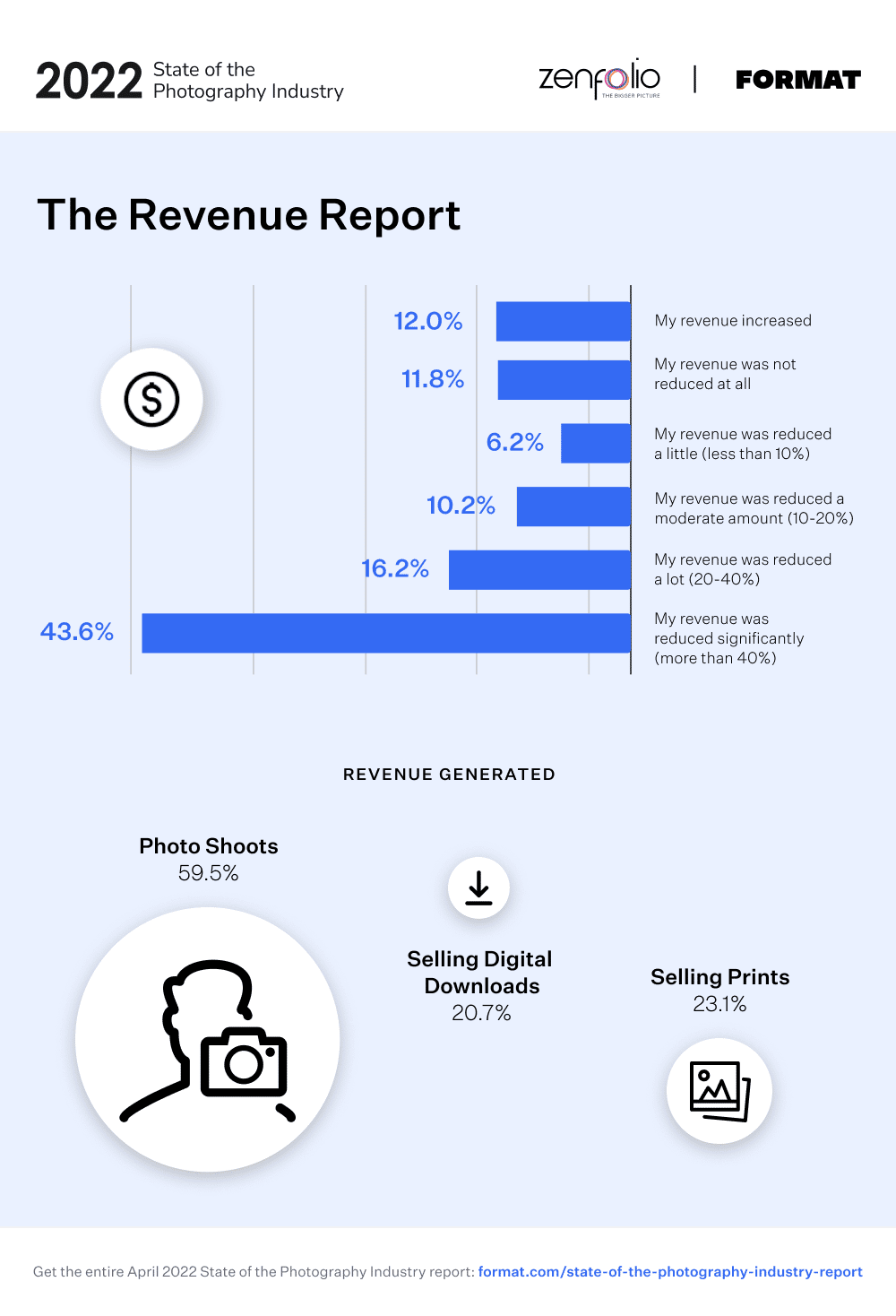Los dos últimos años en los que la pandemia ha dominado los titulares han sido tumultuosos para la mayoría de las industrias, y la fotografía no es diferente. La menor posibilidad de realizar sesiones fotográficas en persona y la indecisión de los clientes a la hora de gastar dinero en un momento de incertidumbre hicieron que los fotógrafos vieran un descenso general de sus ingresos. Ahora, con el levantamiento de las restricciones y la vuelta de gran parte del mundo a las interacciones en persona, los fotógrafos son cautelosamente optimistas sobre sus negocios.
Zenfolio y Format llevó a cabo la Encuesta sobre el estado de la industria fotográfica en febrero de 2021, mayo de 2021 y, más recientemente, en marzo de 2022, siguiendo el impacto de la pandemia en la industria fotográfica mediante encuestas a más de 3.300 fotógrafos de todo el mundo. La valiosa información obtenida ayuda a ofrecer una visión general de cómo los fotógrafos garantizan un crecimiento continuado de sus ingresos, incluso en tiempos de cambio e incertidumbre.
Los datos muestran la resistencia de la industria fotográfica y ofrecen una visión de cómo puedes actuar para hacer crecer tu negocio. Examinaremos tanto la estrategia de subir tus precios como la de aumentar el valor que aportas a tus clientes a través de tu negocio. Poner en práctica una combinación de ambas puede ser una forma eficaz de asegurarte de que estás entre los fotógrafos de todo el mundo que verán aumentar sus ingresos en 2022.
Algunos aumentos regulares de precios son normales y esperables en la mayoría de los sectores, pero en un panorama empresarial y fotográfico en evolución, también examinamos las formas en que puedes hacerte más valioso para tus clientes, garantizando relaciones duraderas y rentables. Los retos sin precedentes que supuso la pandemia también dieron paso a nuevas oportunidades para los fotógrafos, ya que cada vez se comparten y consumen más medios visuales personales y comerciales en Internet. La fotografía es una parte importante de este cambio, y la continua necesidad de imágenes de alta calidad en toda una serie de sectores hace de la fotografía una profesión resistente incluso en tiempos de cambio.
Ponle precio a tu cliente ideal
Cuando se trate de tu estrategia de precios, ten en cuenta la importancia de fijar tus precios pensando en tu cliente objetivo. Puede resultar tentador intentar competir con otros fotógrafos en precio, pero el resultado final de esta estrategia es una disminución gradual de los precios que los clientes están dispuestos a pagar por la fotografía.
El riesgo de fijar precios de fotografía demasiado bajos
Como siempre ha ocurrido con la fotografía, puede ser difícil comunicar a los clientes la razón de tus precios. Los clientes más experimentados comprenderán la cantidad de trabajo que conlleva una sesión fotográfica de éxito, incluida la inversión en equipos de calidad, los años de experiencia y el tiempo dedicado a la preproducción y postproducción. Los que no entienden bien por qué las tarifas de los fotógrafos son las que son, pueden esperar una tarifa más baja que para ellos tenga sentido como una cantidad justa por hora que ganar, pero si permites que esas expectativas dicten tus precios, será muy difícil ser rentable.
Independientemente de a quién te dirijas, tus clientes ideales deben comprender lo que implica un presupuesto de un trabajo de fotografía, y aceptar tus tarifas dentro de lo razonable. Por supuesto, si tu cliente ideal es una gran multinacional, es razonable que tus tarifas sean bastante más altas que si quieres atender a pequeñas empresas. Tus precios deben estar dentro de lo razonable para el cliente ideal con el que te gustaría trabajar.
Si fijas unos precios demasiado bajos, no sólo te estás exponiendo a unos ingresos insuficientes por el trabajo que haces, sino que también estás indicando a tu cliente ideal, que valora la calidad, que quizá no seas tan buen candidato como tus competidores.


Qué indican tus tarifas de fotografía
Para tu cliente ideal, tus tarifas fotográficas deben ser una señal de la calidad y el valor que ofreces. Al competir con precios bajos, estás devaluando tu trabajo y, paradójicamente, puedes ahuyentar a clientes de gran valor que comprenden el trabajo que conlleva crear imágenes de calidad. El informe sobre el Estado de la Industria Fotográfica reveló que la mayoría de los fotógrafos -más de 75% en la mayoría de los sectores- consiguen sus nuevos clientes por el boca a boca. Eso significa que, si fijas precios demasiado bajos, a menudo estarás reduciendo innecesariamente tus ingresos, cuando a tus clientes ideales probablemente les importe más la calidad del trabajo que puedes producir basándote en las recomendaciones de sus amigos que si pueden recortar un poco de dinero de su factura. O, si tu precio es bajo y luego consigues que te recomienden esos clientes, los clientes que te recomienden esperarán un nivel de inversión similar, y entonces te verás atrapado en un ciclo de ingresos más bajos de lo que te gustaría.
Aporta valor a tu práctica fotográfica
Ser fotógrafo profesional es algo más que presentarse a una actuación, hacer las fotos y entregar archivos aceptables a tiempo. Hay muchas formas de aportar más valor a tu práctica fotográfica, convirtiéndote en un socio de confianza para tus clientes. Cuanto más te vean tus clientes como una fuente de valor para su negocio, menos probable será que busquen otros fotógrafos. Además, como método para hacer crecer tu negocio, centrarte en aportar valor a tu práctica fotográfica también se traducirá en más ingresos por cada cliente. Esto es distinto de subir los precios sin más. Puede haber ocasiones en las que esté justificado subir los precios, pero no es tan sencillo como aumentar tus tarifas indefinidamente sin ofrecer nada recíproco a cambio a tus clientes. Entonces, ¿cómo puedes aportar valor a tu práctica fotográfica? Aquí tienes algunas sugerencias para convertirte en un socio valioso en el negocio de tus clientes:
Adelántate a las necesidades de tus clientes
Una forma de demostrar que no sólo haces fotos para que tu cliente gane dinero, sino que realmente te importa su satisfacción personal o el éxito de su negocio, es tomarte un tiempo cada trimestre para mirar hacia delante y anticipar cuáles pueden ser las necesidades de tu cliente y acercarte a él con alguna propuesta o información relevante.

Por ejemplo, considera la lista de clientes de un fotógrafo de familia, una de las categorías de fotógrafos que tuvo más trabajo del esperado en 2021 según el Informe sobre el estado de la industria fotográfica. Puede que hayas estado ocupado con sesiones familiares en el cuarto trimestre, cuando muchas familias contratan fotógrafos para las vacaciones, pero enero y febrero pueden ser más tranquilos. Una forma de añadir valor a tus clientes durante este tiempo sería enviarles un correo electrónico amistoso para saludarles y compartir una breve presentación con fotos de referencia de ideas de sesiones fotográficas de primavera que estés preparando.
Podrías compartir nuevos accesorios y fondos de temporada que hayas adquirido, y ofrecer un descuento por volver o por recomendar a otras familias. Esto demuestra que te preocupas por que consigan imágenes que les encanten durante todo el año.
Tampoco tiene por qué ser siempre un argumento de venta. También puedes compartir algunos consejos de fotógrafo profesional sobre cómo pueden conseguir las mejores imágenes en casa entre sesión y sesión profesional, con consejos para posar o ideas sobre cómo conseguir que los niños pequeños se sienten para hacer buenas fotos. Un boletín ocasional o un correo electrónico directo con este tipo de información que no esté orientada a la venta ayuda a romper con las comunicaciones más promocionales.
Ofrece incentivos especiales
Dependiendo de quiénes sean tus clientes, puede que sólo tengan presupuesto para una o dos sesiones importantes al año. Sin embargo, la mayoría de los clientes seguirían apreciando una minioferta más reducida entre una sesión y otra. Por ejemplo, si eres fotógrafo de productos, puedes aprovechar al máximo los periodos lentos entre las grandes temporadas de comercialización ofreciendo a tus clientes minisesiones para unos pocos productos.
Puedes hacer que varios clientes envíen sus productos, crear unos cuantos sets de fotografía de producto reutilizables y fotografiarlos todos en uno o dos días. Tus clientes valorarán la oferta especial y la oportunidad de obtener imágenes frescas sin tener que reservar una sesión fotográfica costosa, y tú puedes tener un par de días muy rentables consolidando la preparación para muchos clientes diferentes en una sola sesión.
Conviértete en un Líder de Pensamiento
Tener presencia en tu campo ayuda a establecer la confianza y te hace más valioso para tus clientes. Tanto si creas un canal de YouTube para hablar de temas relacionados con la fotografía y relevantes para tu nicho, como si mantienes un blog o haces crecer tu InstagramConvertirse en un líder de opinión conlleva implícitamente más reservas y tarifas más elevadas.
Además, si tienes un número considerable de seguidores, el mero hecho de compartir el trabajo de tu cliente puede proporcionarles algo de marketing gratuito. Por ejemplo, un fotógrafo de moda con muchos seguidores puede generar ingresos para su marca de ropa indie-cliente compartiendo su trabajo con un público amante de la moda. Esto puede ser muy valioso para tus clientes. También demuestra que estás comprometido con el sector y esto dará sus frutos a largo plazo.
Recoge testimonios
Como muestra la Encuesta sobre el Estado de la Industria Fotográfica, el boca a boca es, con diferencia, la forma más importante que tienen los fotógrafos de diversos campos de conseguir nuevos clientes. El marketing boca a boca es auténtico y digno de confianza, por lo que animar a tus clientes a que te recomienden a su red de contactos y recopilar testimonios para ponerlos en la página web de tu portafolio son dos buenos hábitos que debes practicar para aportar más valor a tu práctica fotográfica.
Cómo calcular el precio de la fotografía
Ahora que hemos repasado la importancia de fijar el precio de tu trabajo para tu cliente ideal y de crear valor en tu práctica fotográfica, veamos cómo puedes llegar a una estructura de precios fotográficos que sea justa tanto para ti como para el cliente.
Especialmente para los fotógrafos noveles, puede ser demasiado fácil calcular mal todos los gastos y el tiempo que conlleva realizar una sesión fotográfica excelente. Ten en cuenta estos elementos para asegurarte de que tus precios cubren tus gastos, tiempo y experiencia.
Considera tus objetivos de ingresos anuales
Un buen punto de partida es fijarte un objetivo anual. Si quieres ganar $70.000 este año, ¿cuánto tienes que ganar de media al mes? ¿Cuántos rodajes puedes reservar, planificar, rodar y editar razonablemente en un mes? Si divides tu objetivo de ingresos mensuales por el número de sesiones que puedes reservar de forma realista, tendrás un punto de partida aproximado de tus expectativas.
Por supuesto, es posible que no puedas reservar tantos clientes como te gustaría, o que tu objetivo de ingresos anuales sea irrealmente alto. En estos casos, tendrás que hacer ajustes, pero éste sigue siendo un punto de partida útil para definir tus objetivos. Si quieres contratar $5000 trabajos, puedes empezar a pensar en quiénes son esos clientes ideales que tienen ese presupuesto, y hacer listas de clientes a los que empezar a dirigirte.
Conoce tus costes fijos y variables
Uno de los errores más comunes que cometen los fotógrafos principiantes es no tener una visión realista de los costes de su negocio. Tus gastos fijos son cosas como el equipo, la edición y las tarifas del software de marketing, y el alquiler si tienes un estudio permanente.
Tus rodajes deberían cubrir una parte de todos estos gastos. Por ejemplo, esa cámara $4000 puede ser nueva ahora, pero con cada rodaje es probable que se deprecie ligeramente. Tus clientes no sólo pagan por tu trabajo, sino también por el uso de tu equipo. Según tu especialidad, puedes tener una línea separada en tu factura por el uso del equipo, que puede facturarse por horas o a tanto alzado por sesión. Otras especialidades, como la fotografía familiar o de bodas, simplemente lo incluirían en sus precios sin incluir una partida.
Tus costes variables son los que cambian en función de la cantidad de trabajo que realizas. Por ejemplo, puedes viajar para un rodaje, o tener un ayudante al que sólo contratas para determinados trabajos. Todos ellos deben incluirse en el precio de los trabajos que incurren en esos costes.
Define tu tarifa por hora
Tu tarifa por hora debe reflejar tu destreza y experiencia, así como el grado de demanda. Recuerda que tus horas de trabajo no sólo se aplican a la sesión en sí, sino también al tiempo de preproducción y edición de las fotos.
En especialidades como los retratos y las bodas, la norma del sector es ofrecer una cantidad de tiempo determinada por un precio fijo. Por ejemplo, puedes cobrar $450 por una sesión de retratos de una hora, o $3200 por 7 horas de cobertura de una boda. Para las sesiones comerciales o de productos, puedes optar por que la tarifa horaria de tus facturas se aplique sólo a la duración de la sesión, pero asegúrate de que las partidas de preproducción y edición sean suficientes para cubrir tu tarifa horaria por el tiempo que dediques a esas tareas.
Obtención de ingresos por fotografía durante COVID
Aunque lo peor de la pandemia de COVID ya haya pasado en gran parte por el retrovisor (crucemos los dedos), no se puede negar que ha dejado su huella en la industria fotográfica. Puede que ya hayas hecho algunas de estas cosas para ganar dinero durante la pandemia y estés volviendo a tu fuente de ingresos habitual, pero siempre es una buena idea diversificar tu flujo de ingresos e implementar algunas de estas fuentes de ingresos a distancia en tu negocio.

Vender Impresiones Online
Nuestro informe sobre el Estado de la Industria Fotográfica descubrió que, junto a las sesiones fotográficas, la segunda forma más común en que los fotógrafos generaron ingresos durante la pandemia es la venta de copias impresas en línea. Independientemente de los ingresos anuales, más del 30 por ciento de los fotógrafos con ingresos diversos indicaron que ésta era una de sus fuentes de ingresos.
Las ventas impresas en persona, un enfoque menos favorable a la pandemia, también se señalaron como fuente de ingresos, pero sólo las utilizaron menos del 25% de los fotógrafos.
Crear cursos o talleres
Aunque menos del 10 por ciento de los fotógrafos declararon esta fuente de ingresos, merece la pena tenerla en cuenta. Lo bueno de crear un curso o taller online es su escalabilidad. Una vez que lo hayas creado, puedes seguir comercializándolo y vendiéndolo a nuevos públicos mucho después de haber terminado el trabajo de crearlo.
Autoeditar libros de fotos
Para los bibliófilos, la autoedición de libros de fotos puede ser otra forma remota de ganar dinero como fotógrafo. Fotógrafos de arte, fotógrafos paisajistasy otros en nichos similares pueden vender su trabajo en libros de arte, mientras que los que fotografían familias y bodas pueden ofrecer libros personalizados de sus sesiones fotográficas como complemento para aumentar los ingresos.
Vender descargas digitales
Descargas digitales, como Preajustes de Photoshop y Lightroomson otro potenciador de ingresos escalable. Publicarlas en mercados digitales puede resultar muy rentable aunque sean baratas, siempre que haya un número suficientemente grande de personas dispuestas a pagar por las descargas de fotos digitales.
Cómo mejorar tu flujo de trabajo
Cualquier fotógrafo profesional puede dar fe de que, a veces, los entresijos de la fotografía son los que más tiempo ocupan. Racionalizar el mayor número posible de tareas relacionadas con el funcionamiento de tu negocio puede liberar un tiempo valioso y aumentar tus ingresos finales por hora.
Utilizar una plataforma como Format proporciona acceso a un conjunto de valiosos herramientas aprobadas por fotógrafos profesionalescomo la facturación de clientes integrada, la gestión de clientes, los contratos y las galerías de pruebas de clientes, que agilizan y simplifican la comunicación con tu base de clientes y la gestión de tu negocio. El software adecuado puede ser realmente útil para mejorar tu flujo de trabajo y permitirte centrarte en las cosas importantes, como conseguir tus clientes ideales y ponerte detrás de la cámara.
Así que, en última instancia, cuando se trata de fijar precios, hay pros y contras en subirlos como táctica por defecto. La pandemia fue dura para el sector de la fotografía, y muchos de nosotros perdimos una gran parte de nuestro negocio o tuvimos que abandonar el sector por completo.
En un esfuerzo por volver a donde estabas antes de la pandemia, para recuperar parte de esos beneficios perdidos, es fácil decir simplemente "subiré un poco mis tarifas". Cada paso debe considerarse cuidadosamente, y las necesidades de tu cliente tendrán que entrar en juego. Por mucho que subir tus precios suene como si fuera a generar más ingresos, no siempre es así. Hacer que tus servicios sean más valiosos para tus clientes ideales te llevará muy lejos, y como hemos comentado antes, la mayoría de los fotógrafos consiguen nuevos trabajos por el boca a boca. Asegúrate de que tus clientes sientan que su dinero vale la pena, sin dejar de ofrecerles las imágenes de calidad estelar que has perfeccionado. Ten en cuenta que puedes crear más valor para ti mismo como empresario, de modo que cada dólar que necesites gastar para dirigir tu negocio llegue más lejos. Esto, a su vez, te ayudará a mantener tus precios donde deben estar para tu clientela ideal, mientras aumentan tus ingresos.












